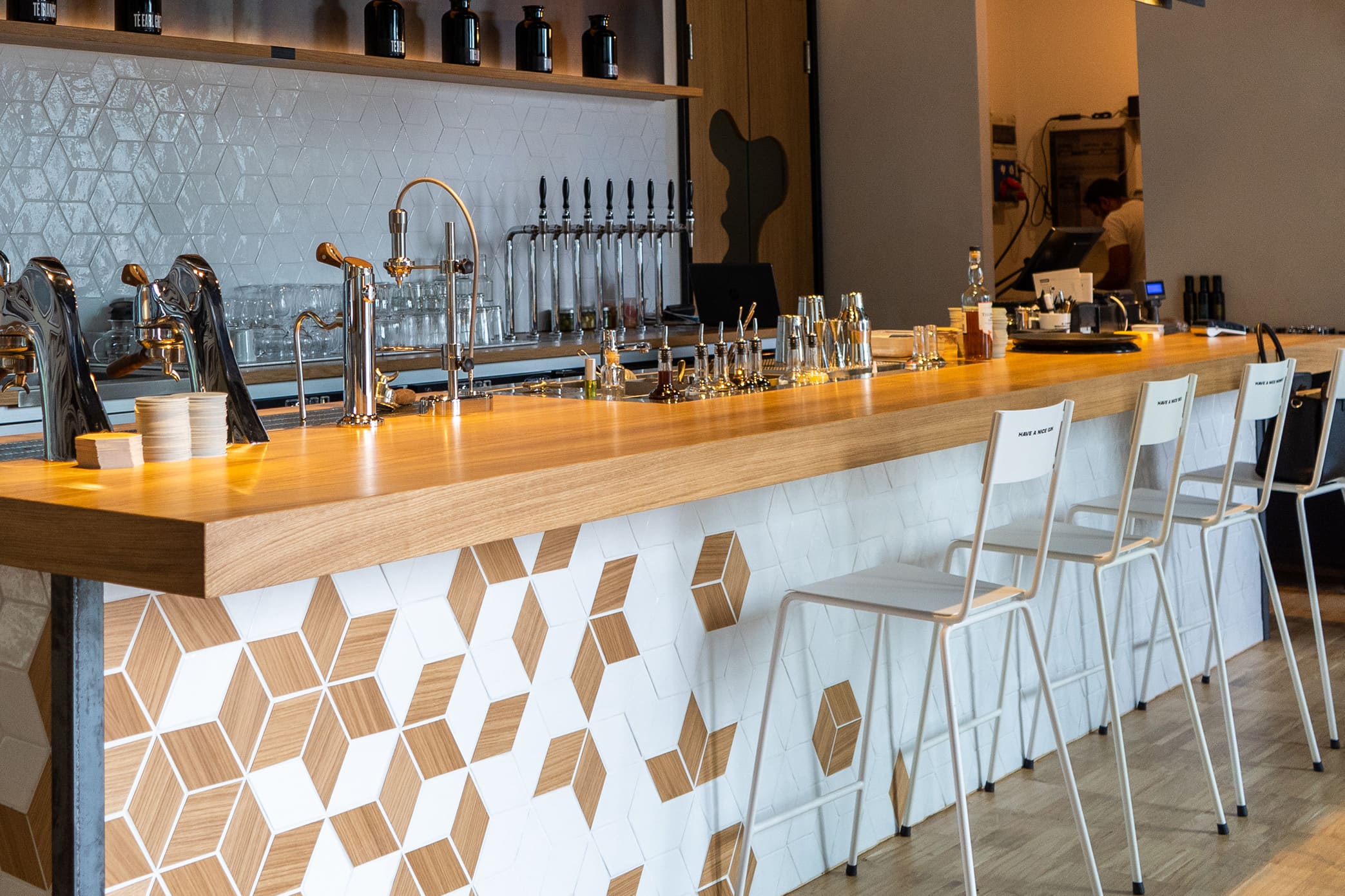- Home
- Connecting
- Tripstillery. The first cocktail bar with a do-it-yourself distillery and a “Francescano” aperitif.
Tripstillery. The first cocktail bar with a do-it-yourself distillery and a “Francescano” aperitif.

All we needed was a do-it-yourself distillery to create our own concoctions, bottle them and even label them. In the center of Milan, under everyone’s eyes and even in compliance with the law. We needed it, and that’s why Tripstillery was born, the first cocktail bar with a still available to anyone who wants to transfer the idea of flavor that buzzes in their head to a unique and limited-edition spirit or liqueur, under the supervision of a master distiller (Francesco Zini). We met Sabina Yausheva, best barlady according to the Identità Golose 2022 Guide and enthusiastic director of Tripstillery. A girl with a “spirit” but very serious when she talks to us about the work she does together with the founder and bar manager Luca Vezzali and Francesco Pagliara, Luca’s right-hand man and, with him, creator of the cocktail list.

PN: The first cocktail bar with an internal distillery open to the public. How does it work? Is there a minimum quantity of bottles for which you start the still?
SY: The “private” production includes a base of 42 bottles that can be extended to 90, at 22 euros each. Our advice is to book in advance so you can count on the presence of Francesco, the master distiller who guides the Customer towards the final recipe, starting from an initial scent, be it juniper, lavender or chamomile. This briefing phase also includes an olfactory test of the spices so as to identify the right notes that will make up the recipe.
PN: Do interested people already have an idea of a distillate in their heads?
SY: It depends on the Customer, in addition to individuals we address small venues and shops that for example have a perfume and want to transform it into a liqueur to give as a Christmas gift. Then there are the gin enthusiasts who make their own production to give as a gift for a birthday or an anniversary.
PN: Do you only distill gin?
SY: It is the star of the moment but we have just released a new release of bitters with an original greenish color compared to the usual amber. Soon we will also produce liqueurs.
PN: What can go wrong with an improvised distiller in his garage at home?
SY: The head and tail are the most harmful parts for health but the entire product contains alcohol, flammable and very volatile. In addition to the risk of explosions, you can also get burned by the ingredients. We are super-controlled, safe and work in an environment closed to non-experts. At home I would recommend dedicating yourself to the infusion of a limoncello at most.
PN: You said that a bartender is a bit like a chef, only that he uses glasses instead of plates and works in contact with the public. Another analogy could be the figure of the DJ who adapts the music to the response of the audience in the room? After all, he also “mixes” ingredients. Staying on topic, do you accept requests? Like “can you add more gin”?
SY: Since I no longer work at the bar, let’s say I left the console to become a manager (or producer). Our priority is to propose our drinks and our ingredients. The mojito is not our cup of tea, if you ask us we’ll direct you to valid alternatives. We strongly advise against adding liquor to a cocktail served partly to respect its balance and partly because Tripstillery has a different mission than a beach bar.
PN: Mixology is experiencing a boom, where experimentation and contamination between beverage and cuisine seem to know no boundaries, so much so that we propose unusual cocktails such as those made with anchovy sauce or pig’s blood. Do you also have any provocations in your glass?
SY: Not having a kitchen but a laboratory, all the food is ready and the processing takes place only on fruit, vegetables and spices, already oriented towards the world of distillery. In the past I worked in places that offered cocktails “contaminated” by the kitchen but, without reaching extreme ingredients. Improvising, if the main dish is pasta with tomato sauce I could make a bloody mary decorated with durum wheat chips and basil.
PN: How did rosemary get into gin and tonics?
SY: It’s a trend started by a well-known Italian brand that was looking for Mediterranean scents. We are very minimal, we can use lemon or an olive or my beloved tea leaves or even dried fruit and flowers. Personally, I like the “fruity floral sweet” but not invasive, it must be delicate like elderberry or chamomile. I don’t like rose, which I have banned from our proposals.
PN: In addition to the naturalness of the ingredients and zero km, through which behaviors, even daily ones, can Tripstillery be defined as an eco-sustainable activity?
SY: Through the type of all the materials, we are plastic free, so no straws, all paper and only glass bottles. We also limit consumption to the bare minimum, stocking only what we know we will consume so as not to generate waste.
PN: A commitment that aligns you with that of Portanuova. By the way, do you like the neighborhood?
SY: I arrived in Milan 10 years ago and I can say that Portanuova is my favorite area. I am originally from Kazakhstan but I have work experience in Rome and this neighborhood reminds me of New York, the city of London, Dubai.
PN: Do you also have a regular clientele of aficionados?
SY: We opened recently but we have our daytime round of offices while in the evening many residents or visitors to the neighborhood pop in for an aperitif or after dinner. Some of them come quite frequently. It is a clientele mainly of millennials, therefore between 25 and 40 years old.
PN: Does the Milanese happy hour of the 1990s still exist?
SY: It first boomed and then crashed because serving sumptuous banquets in exchange for discounted cocktails is an activity with a business model that I struggle to understand. How can it be convenient? The aperitif was created to whet the appetite without fully satisfying it, it must make you feel hungry enough to go to dinner. Our “ape” is “Francescano”, with a block of salt and accompanied by the fabulous olive oil from a small producer in Foggia.
PN: Do people savor cocktails or gulp them down?
SY: The lockdown has educated people who, in closed places, trying to reproduce bar drinks in their homes, have realized how much study, time and work there is behind a well-mixed cocktail with quality ingredients. Speaking of gin and tonic, people have also learned to distinguish tonics, of which they often ask us about the characteristics and origin.
PN: What are the bestsellers?
SY: Gin Tonic and Martini, also out of curiosity to taste our products. Then obviously the Spritz and the Ginger Mule.
PN: Is it possible to pair the ideal cocktail with a dish like you do with wine?
SY: You can go for contrast by balancing acidity and sweetness. Desserts can instead be served with drinks based on the same ingredient, revisited.
PN: What is your favorite cocktail?
SY: I am a huge fan of the Manhattan and the Rob Roy, both whiskey-based, one peaty, one “sweet”. I enjoy them as if they were caresses, especially in winter.
PN: Do you have events in Tripstillery?
SY: Every Thursday, we offer tastings with DJ sets to accompany the aperitif and the intervention of guest bar tenders from all over Italy, in the future also from abroad.
PN: Respect for the environment is realized in the drying and cultivation processes of herbs and spices that come from lands on Lake Iseo owned by Tripstillery. Have you visited these lands?
SY: Not yet but I hope to visit Brazil one day where, who knows, maybe one day we will grow our Coffeellery coffee!
Tripstillery awaits you at Alvar Aalto Square with these opening hours:
Monday to Thursday: 08–01. Friday: 08–02. Saturday: 09–02. Sunday: 09–01